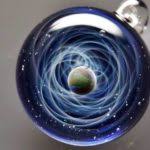DỊCH HOÀN THIỆN ĐỀ THI IELTS READING VÀ GIẢI THÍCH ĐÁP ÁN:
Venus in Transit
June 2004 saw the first passage., known as a 'transit` of the planet Venus across the face of the Sun in 122 years. Transits have helped shape our view of the whole Universe, as Heather Cooper and Nigel Henbest explain.
Tháng 6 năm 2004 chứng kiến chuyến đi đầu tiên, được gọi là 'quá cảnh' của hành tinh Sao Kim qua Mặt trời trong 122 năm. Các lần quá cảnh đã giúp định hình quan điểm của chúng ta về toàn bộ Vũ trụ, như Heather Cooper và Nigel Henbest giải thích
A
On 8 June 2004, more than half the population of the world were treated to a rare astronomical event. For over six hours, the planet Venus steadily inched its way over the surface of the Sun. This “transit` of Venus was the first since 6 December 1882. On that occasion, the American astronomer Professor Simon Newcomb led a party to South Africa to observe the event. They were based at a girls' school, where - if is alleged – the combined forces of three schoolmistresses outperformed the professionals with the accuracy of their observations.
Vào ngày 8 tháng 6 năm 2004, hơn một nửa dân số thế giới đã được chiêu đãi một sự kiện thiên văn hiếm có. Trong hơn sáu giờ, hành tinh Venus đều đặn di chuyển trên bề mặt của Mặt trời. Lần "quá cảnh" này của sao Kim là lần đầu tiên kể từ ngày 6 tháng 12 năm 1882. Nhân dịp đó, giáo sư thiên văn học người Mỹ Simon Newcomb đã dẫn đầu một nhóm đến Nam Phi để quan sát sự kiện. Họ đặt trụ sở tại một trường nữ sinh, nơi - người ta cho rằng - năng lực kết hợp của ba nữ giáo viên đã vượt trội so với các chuyên gia về độ chính xác trong các quan sát của họ.
B
For centuries, transits of Venus have drawn explorers and astronomers alike to the four corners of the globe. And you can put it all down to the extraordinary polymath Edmond Halley. In November 1677, Halley observed a transit of the innermost planet Mercury, from the desolate island of St Helena in the South Pacific. He realized that from different latitudes, the passage of the planet across the Sun's disc would appear to differ. By timing the transit from two widely-separated locations, teams of astronomers could calculate the parallax angle - the apparent difference in position of an astronomical body due to a difference in the observer's position. Calculating this angle would allow astronomers to measure what was then the ultimate goal; the distance of the Earth from the Sun. This distance is known as the 'astronomical unit` or AU.
Trong nhiều thế kỷ, quá trình đi qua của Sao Kim đã thu hút các nhà thám hiểm và nhà thiên văn học đến khắp bốn phương của địa cầu. Và bạn có thể gán nó với cho Edmond Halley, một học giả phi thường. Vào tháng 11 năm 1677, Halley đã quan sát thấy sự đi qua của hành tinh trong cùng Sao Thủy, từ hòn đảo hoang vắng St Helena ở Nam Thái Bình Dương. Ông nhận ra rằng từ các vĩ độ khác nhau, hành tinh này đi qua đĩa Mặt trời sẽ có vẻ khác nhau. Bằng cách định thời gian cho sự di chuyển từ hai địa điểm cách xa nhau, các nhóm nhà thiên văn học có thể tính toán góc thị sai - sự khác biệt rõ ràng về vị trí của một thiên thể do sự khác biệt về vị trí của người quan sát. Việc tính toán góc này sẽ cho phép các nhà thiên văn học đo được mục tiêu cuối cùng khi đó là gì; khoảng cách của Trái đất đến Mặt trời. Khoảng cách này được gọi là 'đơn vị thiên văn' hay AU.
C
Halley was aware that the AU was one of the most fundamental of all astronomical measurements. Johannes Kepler, in the early 17th century, had shown that the distances of the planets from the Sun governed their orbital speeds, which were easily measurable. But no-one had found a way to calculate accurate distances to the planets from the Earth. The goal was to measure the AU; then, knowing the orbital speeds of all the other planets round the Sun, the scale of the Solar System would fall into place. However, Halley realized that Mercury was so far away that its parallax angle would be very difficult to determine. As Venus was closer to the Earth, its parallax angle would be larger and Halley worked out that by using Venus it would be possible to measure the Sun`s distance to 1 part in 500. But there was a problem: transits of Venus, unlike those of Mercury; are rare, occurring in pairs roughly eight years apart every hundred or so years. Nevertheless, he accurately predicted that Venus would cross the face of the Sun in both 1761 and 1769 - though he didn`t survive to see either.
Halley biết rằng AU là một trong những phép đo cơ bản nhất trong tất cả các phép đo thiên văn. Johannes Kepler, vào đầu thế kỷ 17, đã chỉ ra rằng khoảng cách của các hành tinh tính từ Mặt trời chi phối tốc độ quỹ đạo của chúng, vốn có thể đo được dễ dàng. Nhưng không ai tìm ra cách tính toán khoảng cách chính xác từ Trái đất đến các hành tinh. Mục tiêu là để đo AU; khi đó biết được tốc độ quỹ đạo của tất cả các hành tinh khác quay quanh Mặt trời, thì thang đo của Hệ Mặt trời sẽ trở nên rõ ràng. Tuy nhiên, Halley nhận ra rằng Sao Thủy ở rất xa nên rất khó xác định góc thị sai của nó. Khi sao Kim ở gần Trái đất hơn, góc thị sai của nó sẽ lớn hơn và Halley đã tìm ra rằng bằng cách sử dụng sao Kim, có thể đo khoảng cách của Mặt trời chính xác đến 1 phần 500. Nhưng có một vấn đề: sự đi qua của sao Kim, không giống của sao Thủy; rất là hiếm, xảy ra theo cặp cách nhau khoảng tám năm cứ sau một trăm năm. Tuy nhiên, ông đã dự đoán chính xác rằng Sao Kim sẽ đi qua Mặt trời vào cả hai năm 1761 và 1769 - mặc dù ông cũng không sống sót để nhìn thấy.
Fall into place: diễn ra tốt đẹp, không vướng mắc, gặp khó khăn, rõ ràng
D
Inspired by Halley's suggestion of a way to pin down the scale of the Solar System, teams of British and French astronomers set out on expeditions to places as diverse as India and Siberia. But things weren’t helped by Britain and France being at war. The person who deserves most sympathy is the French astronomer Guillaume Le Gentil.
He was thwarted by the fact that the British were besieging his observation site at Pondicherry in India. Fleeing on a French warship crossing the Indian Ocean, Le Gentil saw a wonderful transit - but the ship`s pitching and rolling ruled out any attempt at making accurate observations. Undaunted, he remained south of the equator, keeping himself busy by studying the islands of Mauritius and Madagascar before setting off to observe the next transit in the Philippines. Ironically after travelling nearly 50,000 kilometres, his view was clouded out at the last moment, a very dispiriting experience.

1. Mua bộ đề gần 400 bài ielts reading - Dịch và giải chi tiết Chỉ 199k bao gồm toàn bộ đề trong bộ Cambridge ( từ bộ 1 -19) và nhiều đề thi thực tế ( xem danh sách 400 đề ielts reading tại đây). Xem bài mẫu tại đây, Bài mẫu 1, bài mẫu 2, bài mẫu 3. Giải đề bao gồm phần dịch bài đọc, dịch phần câu hỏi, giải thích chi tiết,( chỉ có thể tải, in phần đề để luyện tập, phần giải chi tiết và dịch chỉ xem online).
>>>>>>> Đặc biệt tặng kèm Dịch và giải chi tiết bộ đề Ielts listening từ Cam 10-18 và tặng kèm hơn 300 đề Ielts thực tế ( không có lời giải chi tiết chỉ có đề và đáp án) ( khác với bộ 400 đề ở trên). Vui lòng điền thông tin theo form tại đây và thanh toán theo thông tin CK trong form.
2. Đặc biệt dành tặng 100 bạn hoàn thành buổi học thử miễn phí khóa học Ielts Speaking online 1 kèm 1, các bạn sẽ được tặng bộ đề 400k bài Ielts reading và bộ đề Ielts Listening bộ Cam từ 10-18 gồm bài dịch và giải chi tiết, giải thích từ vựng khó ( thời hạn sử dụng trong vòng 2 tháng). Xem thông tin khóa học Ielts Speaking online 1 kèm 1 và đăng ký học thử tại đây.
E
While the early transit timings were as precise as instruments would allow the measurements were dogged by the 'black drop' effect. When Venus begins to cross the Sun's disc, it looks smeared not circular - which makes it difficult to establish timings. This is due to diffraction of light. The second problem is that Venus exhibits a halo of light when it is seen just outside the Sun's disc. While this showed astronomers that Venus was surrounded by a thick layer of gases refracting sunlight around it, both effects made it impossible to obtain accurate timings.
F
But astronomers labored hard to analyze the results of these expeditions to observe Venus transits. Jonathan Franz Encke, Director of the Belin Observatory, finally determined a value for the AU based on all these parallax measurements: 153340,000 km. Reasonably accurate for the time, that is quite close to today's value of 149,597,870 km, determined by radar, which has now superseded transits and all other methods in accuracy. The AU is a cosmic measuring rod, and the basis of how we scale the Universe today. The parallax principle can be extended to measure the distances to the stars. If we look at a star in January - when Earth is at one point in its orbit - it will seem to be in a different position from where it appears six months later. Knowing the width of Earth`s orbit, the parallax shift lets astronomers calculate the distance.
G June 2004’s transit of Venus was thus more of an astronomical spectacle than a scientifically important event. But such transits have paved the way for what might prove to be one of the most vital breakthroughs in the cosmos - detecting Earth-sized planets orbiting other stars.
>>>>> Xem thêm:
♦ Tổng hợp câu trả lời, câu hỏi, từ vựng của hơn 70 chủ đề Ielts Speaking part 1
♦ Tổng hợp gần 400 đề thi Ielts reading ( bao gồm dịch, giải chi tiết, từ vựng)
Questions 14-17
Reading Passage 2 has seven paragraphs, A-G.
Which paragraph contains the following information?
Write the correct letter A-G, in boxes 14-17 on your answer sheet.
14. examples of different ways in which the parallax principle has been applied
15. a description of an event which prevented a transit observation
16. a statement about potential future discoveries leading on from transit observations
17. a description of physical states connected with Venus which early astronomical instruments failed to overcome
Questions 18-21
Look at the following statements (Questions 18-21) and the list of people below
Match each statement with the correct person, A, B, C or D.
Write the correct letter A, B, C or D. in boxes 18-21 on your answer sheet.
18. He calculated the distance of the Sun from the Earth based on observations of Venus with a fair degree of accuracy.
19. He understood that the distance of the Sun from the Earth could be worked out by comparing observations of a transit.
20. He realized that the time taken by a planet to go round the Sun depends on its distance from the Sun.
21. He witnessed a Venus transit but was unable to make any calculations.
List of People
A. Edmond Halley
B. Johannes Kepler
C. Guillaume Le Gentil
D. Johann Franz Encke
Questions 22-26
Do the following statements agree with the information given in Reading Passage 2?
Write answers in boxes 22-26 on your answer sheet. write
TRUE it the statement agrees with the information
FALSE if the statement contradicts the information
NOT GIVEN if there is no information on this
22. Halley observed one transit of the planet Venus.
23. Le Gentil managed to observe a second Venus transit.
24. The shape of Venus appears distorted when it starts to pass in front of the Sun.
25. Early astronomers suspected that the atmosphere on Venus was toxic.
26. The parallax principle allows astronomers to work out how far away distant stars are from the Earth.
ĐÁP ÁN, GIẢI CHI TIẾT và DỊCH HOÀN THIỆN ĐỀ THI IELTS READING:
Venus in Transit
Questions 14-17
Reading Passage 2 has seven paragraphs, A-G.
Which paragraph contains the following information?
Write the correct letter A-G, in boxes 14-17 on your answer sheet.
14.F examples of different ways in which the parallax principle has been applied
ví dụ về những cách khác nhau trong việc áp dụng nguyên tắc thị sai
Giải thích:
The parallax principle can be extended to measure the distances to the stars. If we look at a star in January - when Earth is at one point in its orbit - it will seem to be in a different position from where it appears six months later. Knowing the width of Earth`s orbit, the parallax shift lets astronomers calculate the distance.
15.D a description of an event which prevented a transit observation
mô tả về một sự kiện ngăn cản việc quan sát quá cảnh
Giải thích:
He was thwarted by the fact that the British were besieging his observation site at Pondicherry in India. Fleeing on a French warship crossing the Indian Ocean, Le Gentil saw a wonderful transit - but the ship`s pitching and rolling ruled out any attempt at making accurate observations.
Questions 18-21
Look at the following statements (Questions 18-21) and the list of people below
Match each statement with the correct person, A, B, C or D.
Write the correct letter A, B, C or D. in boxes 18-21 on your answer sheet.
18.D He calculated the distance of the Sun from the Earth based on observations of Venus with a fair degree of accuracy.
Ông đã tính toán khoảng cách từ Mặt trời đến Trái đất dựa trên các quan sát về Sao Kim với độ chính xác khá cao.
Giải thích: đoạn F
But astronomers labored hard to analyze the results of these expeditions to observe Venus transits. Jonathan Franz Encke, Director of the Belin Observatory, finally determined a value for the AU based on all these parallax measurements: 153340,000 km. Reasonably accurate for the time, that is quite close to today's value of 149,597,870 km, determined by radar, which has now superseded transits and all other methods in accuracy.
Questions 22-26
Do the following statements agree with the information given in Reading Passage 2?
Write answers in boxes 22-26 on your answer sheet. write
TRUE it the statement agrees with the information
FALSE if the statement contradicts the information
NOT GIVEN if there is no information on this
22.F Halley observed one transit of the planet Venus.
Halley đã quan sát thấy một lần quá cảnh của hành tinh sao Kim.
Giải thích: đoạn C, ông nhìn thấy quá cảnh của sao thủy chứ không phải sao Kim
Nevertheless, he accurately predicted that Venus would cross the face of the Sun in both 1761 and 1769 - though he didn`t survive to see either.
Answer:
14. F
15. D
16. G
17. E
18. D
19. A
20. B
21. C
22. FALSE
23. FALSE
24. TRUE
25. NOT GIVEN
26. TRUE
1. Mua bộ đề gần 400 bài ielts reading - Dịch và giải chi tiết Chỉ 199k bao gồm toàn bộ đề trong bộ Cambridge ( từ bộ 1 -19) và nhiều đề thi thực tế ( xem danh sách 400 đề ielts reading tại đây). Xem bài mẫu tại đây, Bài mẫu 1, bài mẫu 2, bài mẫu 3. Giải đề bao gồm phần dịch bài đọc, dịch phần câu hỏi, giải thích chi tiết, ( chỉ có thể tải, in phần đề để luyện tập, phần giải chi tiết và dịch chỉ xem online).
>>>>>>> Đặc biệt tặng kèm Dịch và giải chi tiết bộ đề Ielts listening từ Cam 10-18 và tặng kèm hơn 300 đề Ielts thực tế ( không có lời giải chi tiết chỉ có đề và đáp án) ( khác với bộ 400 đề ở trên). Vui lòng điền thông tin theo form tại đây và thanh toán theo thông tin CK trong form.
2. Đặc biệt dành tặng 100 bạn hoàn thành buổi học thử miễn phí khóa học Ielts Speaking online 1 kèm 1, các bạn sẽ được tặng bộ đề 400k bài Ielts reading và bộ đề Ielts Listening bộ Cam từ 10-18 gồm bài dịch và giải chi tiết, giải thích từ vựng khó ( thời hạn sử dụng trong vòng 2 tháng). Xem thông tin khóa học Ielts Speaking online 1 kèm 1 và đăng ký học thử tại đây.

.png)

.jpg)




